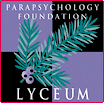 |
 |
| The First International Conference of Parapsychological Studies Carlos S. Alvarado Parapsychology Foundation 
Afternoon Session in the Senaatszaal University of Utrecht, 1953 The First International Conference of Parapsychological Studies was held at Utrecht between July 30 to August 5 of 1953 to present the state of the art of aspects of parapsychological research, recent research, theory, and to chart future developments. The conference was the first major project of the Parapsychology Foundation (PF), which was funded in 1951 by Eileen J. Garrett. The PF funded the meeting, which was co-sponsored with the University of Utrecht. Most of the PF’s funds came from Frances P. Bolton, the Foundation’s Vice-President. 
The Honorable Frances Payne Bolton, Vice President of the Parapsychology Foundation and Congressman from Ohio and Mrs. Eileen J. Garrett, President of the Parapsychology Foundation An initial organizational meeting was held in Paris in December of 1952 to consider ideas for the conference provided by Garrett. The group decided that the event should take place at Utrecht in 1953, and that Gardner Murphy should be appointed Chair of the convention, and Michel Pobers, from the PF, its Secretary General. An Executive Committee was formed under Murphy that included Hans Bender, Emilio Servadio, S.G. Soal, René Sudre, and Wilhelm H.C. Tenhaeff, among others. The congress took place at the University of Utrecht as a joint effort of the PF and the University. The daily schedule was divided between meetings of working groups and plenary sessions. The proceedings were both filmed and taped, and translations services were offered to the attendants. Seventy-eight members of the congress from 13 countries were listed in the proceedings, of which 59% were presenters. Among them were many figures well-known in parapsychological circles such as the above mentioned members of the Executive Committee, and such individuals as Eric J. Dingwall and Gertrude Schmeidler. Some members of the conference were eminent figures in their fields, such as philosophers Gabriel Marcel and H.H. Price, and well-known psychologists as Gardner Murphy, Robert H. Thouless, and D.J. van Lennep. 
In addition to plenary sessions on a variety of topics the conference was organized around working groups, the main being quantitative studies, the psychotherapeutic and psychoanalytic approach, spontaneous phenomena and qualitative research, and the personality of the sensitive. There were also roundtables about parapsychology and the natural sciences, healing, and philosophical issues, and special papers on constructing a glossary of terms in several languages (Robert Amadou), and on the compilation of a bibliography of parapsychology (Gebhard Frei). Garrett gave a pledge at the end of the conference to support parapsychology for the next five years. There were committees that, among other things, recommended the organization of future conferences on specific topics such as philosophy, psychology, and spontaneous cases, and the compilation of an international bibliography. All of this took place years later and represents an important contribution of the conference to parapsychology. But perhaps the PF’s grant program, and its organization of the above mentioned conferences, represents the most important of the outcome of the conference for the future of parapsychology. The ideas for the later conferences came from the attendants at Utrecht, and they were later brought to fruition through the work and resources of the PF. Such an important modern example of the social history of parapsychology deserves more in-depth exploration. For the Utrecht I page on the main PF website, click here. |
 |

|
 www. parapsychology. org |
||